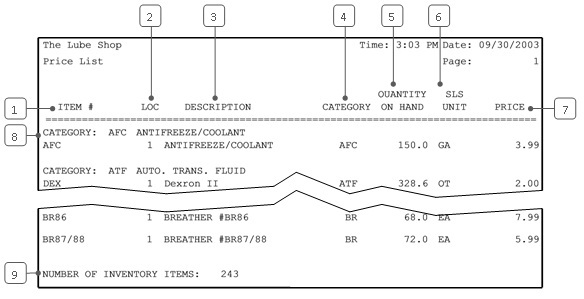The Price List is the master list of prices for all inventory items. Items are reported by category, including the following information for each item:
The total number of items on the list is shown at the end of the list.
Use the following steps to print a Price List:
| Field | Definition | ||
|---|---|---|---|
| Category | Type a category code or range of codes of the categories you want to select. Leave blank for all categories. | ||
| Item Number | Type one item number if you want one particular item, or type a range of item numbers if you want several consecutive items. Leave blank for all items. | ||
| Prime Vendor | Type the primary vendor name (exactly as it is on the Set Up Inventory Items screen). The primary vendor is the first vendor listed on the Set Up Inventory Items screen for an item. Leave blank for all vendors.
|
||
| Print Time on Report | Printing the time helps you identify the most current report when the same report is printed more than once during a day. This field defaults to Y to print the time on the report. If you do not want the time to print on a report, type N. We recommend that you always print the time on a report. | ||
| Duplex | This field appears for terminals that have report type 2 enabled in the Set Up Printer Controls screen. Duplex mode enables printing on both sides of the paper.
|
||
| Number of Printed Lines per Page | This value tells the computer how many lines to print on each page of the report. A typical 11-inch page can contain up to 66 lines, but this field defaults to 60 to allow three-line margins at the top and bottom of the page.
|
||
| Total Number of Lines per Page | This field indicates the length of the paper in the printer. A typical 11-inch page contains 66 lines. Your system interprets a 0 or 66 in this field to mean that standard 11-inch paper is loaded in the printer. Because a 66 causes a form feed to take more time, accepting the default, 0, is recommended. | ||
| Print Report To | This field tells the computer where to send the report. The following list contains the different selections available for this field.
|
||
| Command Line Options | The line at the bottom of the screen contains commands to print the report and to save or change the report settings.
|
You can set up the system on the Set Up Closing Processes screen (1-6-3) to print a current report automatically during closing processes.

| Callout | Item | Description |
|---|---|---|
| 1 | Item # | Identification number of the inventory item. |
| 2 | Loc | Location. This code identifies the location or profit center (such as a lube shop or car wash). |
| 3 | Description | Description of the inventory item. |
| 4 | Category | Category of the inventory item. |
| 5 | Quantity On Hand | Current quantity on hand in sales units. For services, this value is zero. |
| 6 | Sls Unit | Sales unit. Unit of measure in which the item is sold and inventoried. For example, if the entry in this column is EA (each), the item is sold individually. (This is blank for services.) |
| 7 | Price | Retail price per sales unit. |
| 8 | Category | Inventory category of the items that follow. |
| 9 | Number of Inventory Items | Total number of inventory items listed on the report. |
You should print this list when you are setting up inventory items in order to check your prices. Look at both the price and the category for each item to make sure they are correct. You can also run this report on a regular basis or as needed to keep track of prices over time. For example, a current copy of this list might be a good employee reference.
You can make use of this report on a daily basis to keep track of the quantity on hand of items in your store. For this purpose, you should run the report daily. You can limit this report by primary vendor if you want to look at the prices or on-hand quantities associated with a specific vendor’s merchandise. For example, this may be useful if you want to compare the sales price with the purchase cost of items from that vendor or to place an order with the vendor.